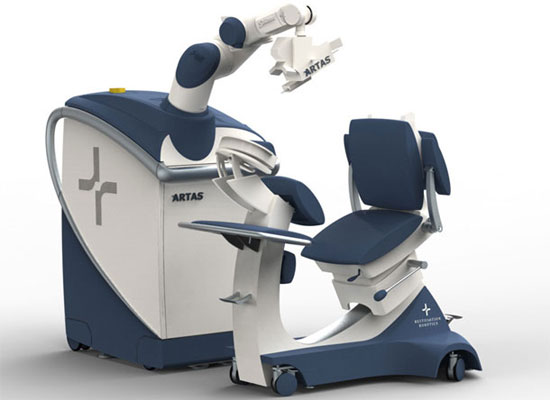Snippet from the article:
Medical device company Restoration Robotics Inc. said Thursday the Food & Drug Administration approved its system for treating hair loss.
Mountain View-based Restoration Robotics, which is privately held, said the system harvests hair follicles from the scalp in men diagnosed with male pattern hair loss with black or brown straight hair.

Read the full story — FDA approves Restoration Robotics system for treating hair loss
 This product has limited use, as it only performs the FUE (follicular unit extraction) harvesting, not the implantation of the grafts, which is by far the most challenging technical aspect of the hair transplant process. The learning curve for manual FUE takes a few months, but the learning curve for placing the grafts easily approaches one year. For the novice surgeon who never learned the manual FUE technique, it allows that person (with minimal training) to produce a high quality FUE process.
This product has limited use, as it only performs the FUE (follicular unit extraction) harvesting, not the implantation of the grafts, which is by far the most challenging technical aspect of the hair transplant process. The learning curve for manual FUE takes a few months, but the learning curve for placing the grafts easily approaches one year. For the novice surgeon who never learned the manual FUE technique, it allows that person (with minimal training) to produce a high quality FUE process.
In our original article which introduced FUE to the hair transplant community a decade ago, we categorized patients in 5 categories to determine which were the best and the worst patients for FUE (Fox class 1 was the best and Fox class 5 was the worst). In that article, we reported the worst Fox class 5 patients reflected about 20% of the population. It remains to be seen whether the robot can produce the high quality grafts with minimal damage in the Fox class 5 patient. Today, I believe that only about 10% of patients would be classed by me as a Fox class 5.
The cost of the robot, I believe, will be very high (significantly more than $100,000)… so the market will be small. There are many alternative approaches to the FUE technology, as there must be more than a dozen extraction devices produced. Some work, but many do not. Despite the automation of the extraction process, I doubt that this robot will become today’s ‘Standard of Care’. There is no doubt that the FUE technique has been well defined and proven today with the various techniques, but there are still a number of doctors who perform the technique very poorly. I have unfortunately seen too many of their failures in my office. At least with the robot, I would expect that the patient will be confident that what he is paying for and what he is going to get is what he expects he will get, and that alone should help the patient make a decision about their surgeon (if there are any doubts as to their chosen surgeon’s competency).
I must reveal here that we have a vested interest in the success of this particular robot, as we licensed the core optical technology for the robotic FUE technique many years ago. Seeing that the product finally has come to the market is very satisfying to us. We have also developed comparable hardware technology for placing grafts and obtained US patents in this arena, so when and if Restoration Robotics moves into graft placing, we can finally say that the automation process is complete.
 I am told the robot will cost about $250,000. I think that this has to be paid down and the result should be a more expensive hair transplant. At least initially. I am just speculating, though, as we don’t have the robot in our practice.
I am told the robot will cost about $250,000. I think that this has to be paid down and the result should be a more expensive hair transplant. At least initially. I am just speculating, though, as we don’t have the robot in our practice. ![]()
![]()





 This product has limited use, as it only performs the FUE (follicular unit extraction) harvesting, not the implantation of the grafts, which is by far the most challenging technical aspect of the hair transplant process. The learning curve for manual FUE takes a few months, but the learning curve for placing the grafts easily approaches one year. For the novice surgeon who never learned the manual FUE technique, it allows that person (with minimal training) to produce a high quality FUE process.
This product has limited use, as it only performs the FUE (follicular unit extraction) harvesting, not the implantation of the grafts, which is by far the most challenging technical aspect of the hair transplant process. The learning curve for manual FUE takes a few months, but the learning curve for placing the grafts easily approaches one year. For the novice surgeon who never learned the manual FUE technique, it allows that person (with minimal training) to produce a high quality FUE process. If you feel the need to verify that you got what you paid for or what the doctor represented to you in regard to the
If you feel the need to verify that you got what you paid for or what the doctor represented to you in regard to the